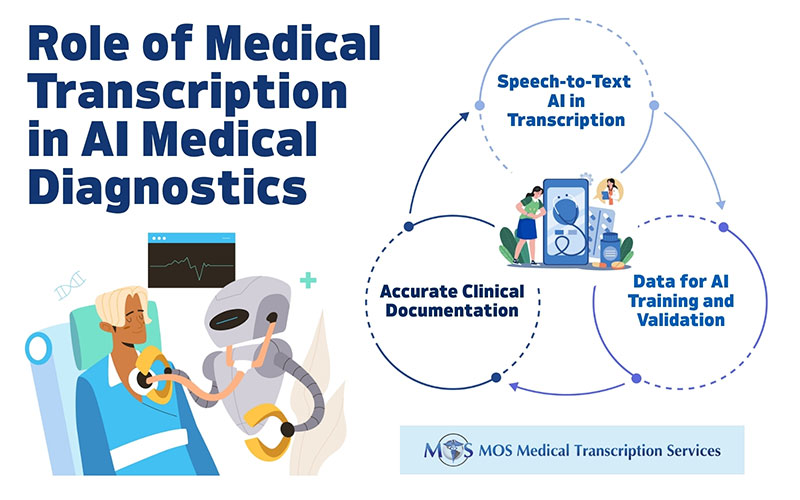A good patient-doctor relationship is vital to ensure quality patient care and medical transcription services minimize the burden of medical documentation on physicians so that they can spend more quality time with the patient and improve their productivity. Tedious medical documentation can stress and burnout physicians and affect doctor patient interactions. This is because patients may be looking up to their physicians as regards health practices and behaviours in addition to receiving their knowledge and expertise. Physicians could set a good example for patients and thereby have a strong public health influence. Understanding patient’s perception of physicians is important to explore their feelings about their care.

A final year medical oncology trainee Ricky Frazer working at Velindre Cancer Centre in Wales says in a bmg.com article that it is important to empower patients to be partners in decision making. As a patient himself, due to Guillain Barré syndrome, he has given new insights about what patients want and what they think about a physician.
- Access to various sources of information: Healthcare providers often advise patients about good sources of information and the risks of searching for information on Google about their diagnosis and treatment. Some departments like oncology, neurology etc have nurses working with the team whom the patient can talk to afterwards and there are many support groups online that you can join. Prior medical knowledge and abundant information about a disease and its symptoms, signs etc can be confusing. So, Google should not be recommended to patients. The information provided to the patient should be comprehensive rather than a single summary sheet on medical condition.
- Know the routine results: Doctors often request routine tests and add them to the patient’s notes. Knowing the routine blood test results is important for patients. Telling your patients about their routine blood report will take only a few minutes. You can also assign nursing staff to provide this information to the patients. This will help minimize unnecessary anxiety in patients.
- Patients would want doctors to realize that for them as inpatients the day doesn’t start with the doctor’s ward round: Doctors should remember that for inpatients days in the hospitals can be very long. Their day starts as early as 7am with nurses’ changeover or maybe even earlier when the water jug is changed. For many patients, the morning routine may seem like a military operation. The reality is that many patients need to go for shower or get ready. So, a couple of hours at the start of the day are essential for patients to perform drug rounds, showers, and have breakfast. Doctors have to be mindful of the challenging tasks that health professionals and patients have apart from waiting patiently to be seen by their doctor and team.
- Patients want to know their journey: Patients often see the nurses discuss their case, which usually occurs at a distance from the patients. Patients are often not involved in the discussion and sometimes junior doctors quickly summarize the case. All patients may not know or understand the seriousness of their disease. As a part of empowering patients it is important to be open and honest in front of the patients.
- A small help can be a boost: Some patients become very weak and need assistance to go to the bathroom or to get undressed etc. Healthcare assistance can be a boon to the patients and any kindness and compassion shown to patients who are weak and vulnerable can provide a moral boost.
A 2017 study titled “Patient Provider Relationship Study” which included 2100 patients in the age group 21 to 70, found that all patients wanted four key things:
- Better connectivity: Unable to reach a physician at the time of urgency is frustrating for patients and according to the study, millennials’ preference for convenience is changing the traditional healthcare system. Today’s patients are tech savvy and they expect a better digital experience from their healthcare providers. An ideal way to improve connectivity is by leveraging mobile apps. There are customized apps that allow patients to communicate with hospital staffs, book appointments easily, pay bills, and change appointment schedules.
- Use of technology: Today, almost everyone owns a mobile phone and patients are more likely to go online via their mobile phones. Patients are attracted to technologies that would help them better manage their appointment with the doctor. A growing number of people also prefer receiving appointment reminders and other information through a secure text message. Studies show that around 73 percent of patients want to be able to text their doctor’s office whereas 79 percent would like to receive text messages from their doctor. Physicians can facilitate patient preference with the help of automated text reminders, follow-up reminders, patient confirmation, and last minute schedule.
- More quality time with the doctor: One of the most common complaints among patients is that they don’t get time to spend with the doctor. This is due to the physician’s increased paperwork, heavy workloads, medical documentation and the physicians are already over burdened that they are unable to spend time with the patients. However, with the right technology physicians can minimize their stress.
According to a Mayo Foundation study, a strong patient physician relationship is fostered by ensuring the following things:
- Eye contact: Which creates a sense of connecting, listening and caring
- Partnership: A two way proposition where both patient and the physician are comfortable
- Communication: Honest and open communication between patients and physicians is essential especially in serious cases, so that patients can openly address their fears and concerns to the physician and develop a sense of trust and confidence in the treatment and achieve the positive results. Good communication also ensures better patient engagement.
- Time: Time is what physicians do not have and what patients want from healthcare providers. Patients want to spend quality time with their physicians to share their concerns, clarify doubts and build a good rapport.
Healthcare providers should approach the patient with a pleasant smile and this makes patients much more comfortable. With the introduction of EHR, doctors and nurses are forced to spend most of their time in health record documentation and other administrative work and spend less time with patients. Handing over the medical documentation process to an established medical transcription company could enable physicians and nurses to spend more quality time with the patients and establish a strong patient-doctor relationship.


